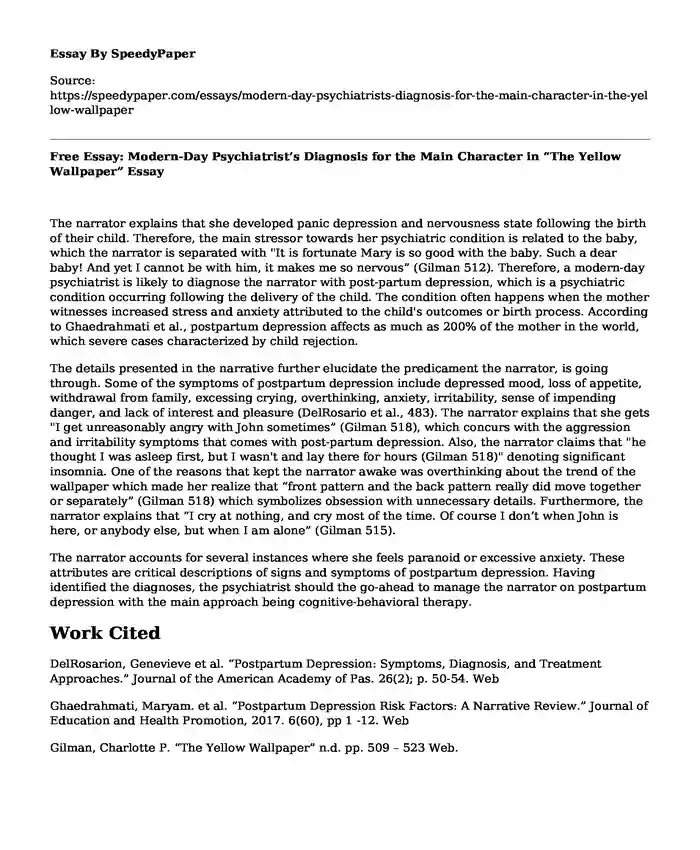
| Essay type: | Book review |
| Categories: | Parenting Depression Anxiety disorder The Yellow Wallpaper Behavior change |
| Pages: | 2 |
| Wordcount: | 418 words |
The narrator explains that she developed panic depression and nervousness state following the birth of their child. Therefore, the main stressor towards her psychiatric condition is related to the baby, which the narrator is separated with "It is fortunate Mary is so good with the baby. Such a dear baby! And yet I cannot be with him, it makes me so nervous” (Gilman 512). Therefore, a modern-day psychiatrist is likely to diagnose the narrator with post-partum depression, which is a psychiatric condition occurring following the delivery of the child. The condition often happens when the mother witnesses increased stress and anxiety attributed to the child's outcomes or birth process. According to Ghaedrahmati et al., postpartum depression affects as much as 200% of the mother in the world, which severe cases characterized by child rejection.
The details presented in the narrative further elucidate the predicament the narrator, is going through. Some of the symptoms of postpartum depression include depressed mood, loss of appetite, withdrawal from family, excessing crying, overthinking, anxiety, irritability, sense of impending danger, and lack of interest and pleasure (DelRosario et al., 483). The narrator explains that she gets "I get unreasonably angry with John sometimes” (Gilman 518), which concurs with the aggression and irritability symptoms that comes with post-partum depression. Also, the narrator claims that "he thought I was asleep first, but I wasn't and lay there for hours (Gilman 518)" denoting significant insomnia. One of the reasons that kept the narrator awake was overthinking about the trend of the wallpaper which made her realize that “front pattern and the back pattern really did move together or separately” (Gilman 518) which symbolizes obsession with unnecessary details. Furthermore, the narrator explains that “I cry at nothing, and cry most of the time. Of course I don’t when John is here, or anybody else, but when I am alone” (Gilman 515).
The narrator accounts for several instances where she feels paranoid or excessive anxiety. These attributes are critical descriptions of signs and symptoms of postpartum depression. Having identified the diagnoses, the psychiatrist should the go-ahead to manage the narrator on postpartum depression with the main approach being cognitive-behavioral therapy.
Work Cited
DelRosarion, Genevieve et al. “Postpartum Depression: Symptoms, Diagnosis, and Treatment Approaches.” Journal of the American Academy of Pas. 26(2); p. 50-54. Web
Ghaedrahmati, Maryam. et al. “Postpartum Depression Risk Factors: A Narrative Review.” Journal of Education and Health Promotion, 2017. 6(60), pp 1 -12. Web
Gilman, Charlotte P. “The Yellow Wallpaper” n.d. pp. 509 – 523 Web.
Cite this page
Free Essay: Modern-Day Psychiatrist's Diagnosis for the Main Character in "The Yellow Wallpaper". (2023, Aug 22). Retrieved from https://speedypaper.com/essays/modern-day-psychiatrists-diagnosis-for-the-main-character-in-the-yellow-wallpaper
Request Removal
If you are the original author of this essay and no longer wish to have it published on the SpeedyPaper website, please click below to request its removal:
- Comparison Essay Sample: Healthcare System in the U.S. and Japan
- Free Essay Describing the Case Study of Electrolyte Imbalances
- Paper Example: The Best Age at Which Children Should Start School
- Paper Example on the Role of Interferon Response in Containing Human Pathogenic Bourbon Virus
- Essay Sample on Frontline Healthcare
- U.S. History of Patient Consent. Free Essay
- Paper Sample on Educational Plan in Community
Popular categories




